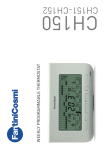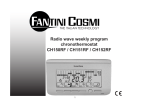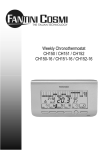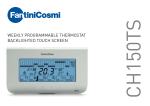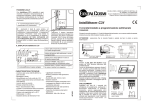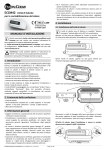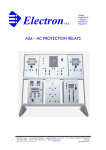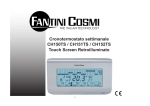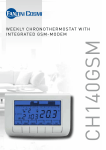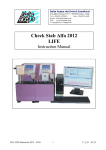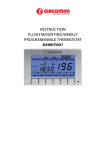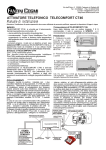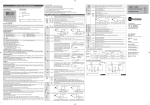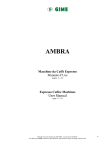Download CH130RFR GB79335D Erp.indd
Transcript
CH130RFR RADIO FREQUENCY AMBIENT THERMOSTAT FOR FAN-COILS TABLE OF CONTENTS Inserting and replacing the batteries .................9 Introduction ..............................................................3 CH172DRF self-learning procedure ..................9 Controls and signals ................................................4 Thermostat configuration .................................10 Controls .............................................................4 Technical features of the thermostat ......................13 Signals ...............................................................4 DIN bar CH172DRF actuator .................................13 User’s manual .........................................................5 Application and use .........................................13 “Summer / Winter” selection ..............................5 Fastening and connecting ...............................14 Operating modes ...............................................6 Operation .........................................................14 “Comfort” operating mode .................................6 Operation check ..............................................15 “Economy” operating mode ...............................6 Technical features of the actuator ..........................16 “OFF” function (OFF) .........................................7 Fan speed selection ..........................................7 Maintenance ............................................................7 Installation ...............................................................7 Fastening the socket .........................................8 Electric connections ..........................................8 Fastening the thermostat onto the socket .........9 2 Introduction The settings and data are stored in a permanent memory capable of keeping the same even when the batteries are not inserted. This fan-coil thermostat control kit CH130RFR is made up of a CH130RF thermostat and a DIN bar CH172DRF actuator. The CH130RF model is a fan-coil 4- or 2-pipe thermostat that allows you to control the ambient temperature both in the heating and cooling mode. These controls are sent to a CH172DRF actuator that communicates with the CH130RF through radio frequencies. The CH130RF is powered by two AA-size batteries (1.5 V). It is able to drive two valves and control a 3-speed fan-coil motor, in manual mode. The thermostat measures the ambient temperature either through an internal probe or an external sensor. It keeps the set-point by acting on the ventilation speed. The wide display shows the measured temperature, the fan speed, the program being run and the selected season. 3 Controls and signals Signals Controls 9 5 1 2 6 3 4 1 2 3 4 5 7 8 1. Measured temperature 2. “Comfort” symbol 3. “Economy” symbol 4. “Summer” symbol 5. “Winter” symbol 6. Fan speed symbols 7. System “ON” in summer operation 8. System “ON” in winter operation 9. Low battery charge 1. Fan speed increase button 2. Fan speed decrease button 3. Selected program temperature value increase button 4. Selected program temperature value decrease button 5. Thermostat reset button Button combinations (press simultan.) 1+2 Summer/Winter switch 3+4 Comfort/Economy switch 2+4 Celsius/Fahreneit switch 4 User’s manual “Summer / Winter” selection To switch from the “Winter” operation (i.e. heating system) to the “Summer” operation (i.e. cooling system), and vice versa, press the 1+2 button combination. The selected operation will be indicated on the display by the “Winter” or “Summer” icons. First of all, make sure that the self-learning procedure has already been performed (page 8); moreover, verify that both the CH130 and the CH172D are 30 metres far from each other at the most. In fact, this distance represents the free air maximum range for the radio frequency modules used by the thermostat and the actuator. Please note that the range will decrease if obstacles are found between the CH130RF and the CH172DRF. Winter Summer To start the thermostat after the same has been installed, proceed as follows: TOP COVER 1. Select the Summer / Winter operation; 2. Select the operating mode; 3. Select the fan speed. THERMOSTAT FRONT 5 Operating modes The CH130RF thermostat features three different manual operating modes: “Comfort”, “Economy”, and the “OFF” function (OFF). “Economy” operating mode With the “Economy” operating mode, the thermostat regulates the heating or cooling system operation in order to always keep the same economy temperature set. To switch from “Comfort” to “Economy”, press buttons “3” and “4” simultaneously. “Comfort” operating mode With the “Comfort” operating mode, the thermostat regulates the heating or cooling system operation in order to always keep the same comfort temperature set. To switch from “Economy” to “Comfort”, press buttons “3” and “4” simultaneously. The temperature level can be modified during operation by means of buttons “3” and “4”. The temperature can be changed from 2°C to 40°C by 0.1°C steps. The temperature level can be modified during operation by means of buttons “3” and “4”. The temperature can be changed from 2°C to 40°C by 0.1°C steps. 6 Maintenance “OFF” function (OFF) The “OFF” function can be achieved by setting the fan speed to zero: in this case, the thermostat will carry out no heat regulation, not even the antifreeze one. The system will switch off automatically, and the “OFF” message will appear on the display. The thermostat should be cleaned by using a soft cotton cloth. No detergent should be used. Installation Warning! The thermostat shall be installed only by qualified personnel, in strict compliance with the law regulations in force. The thermostat installation involves carrying out the following operations: • Fastening the socket; • Making the electric connections; • Fastening the thermostat onto the socket; • Inserting and replacing the batteries; • Configuring the thermostat parameters. Fan speed selection The fan speed can be set either to three fixed levels (minimum, medium, maximum) by pressing buttons “1” and “2”. 7 Fastening the socket The thermostat is supplied complete with a socket suitable for mounting both on the wall and to rectangular or round built-in 3-seat boxes (503). corner. To ensure correct operation, the socket shall be placed at a height of approximately 1.5 metres from the floor, far from heat sources (direct sunlight, etc.) and doors/windows. BATTERY COMPARTMENT Electric connections External probe connection SCREWS SOCKET FASTENING HOLES MULTI-POLE CONNECTOR 60.0 83 DRILLING CENTERS Remove the thermostat top cover. Separate the thermostat socket and front by removing the screw by means of a suitable tool and taking the front part off. Connect the two external probe wires with screwed terminals “1” and “2”, as illustrated in the figure. Such probe can be configured as external probe or minimum temperature contact. See the “thermostat configuration” paragraph, P02 parameter. Fasten the socket to the desired surface by means of the special fastening holes; make sure that the socket is properly engaged, with no deformation, and that the connecting multipole connector is located in the right bottom 8 Fastening the thermostat onto the socket Insert and screw the thermostat down to the socket (make sure that the multi-pole connector is engaged correctly). range is approximately 30 metres in the free air). To perform self-learning, proceed as follows: keep the CH172DRF button depressed for at least 5 seconds, until the multicolour LED comes on by switching among green, yellow, red and OFF. Then press the CH130RF reset button: after a few instants, the LED will be blinking fast and then illuminate green steadily, to indicate that the self-learning has occurred (this procedure is also described in the CH172DRF instruction sheet). Inserting and replacing the batteries Insert two “AA” batteries (1.5 V) into the battery compartment, according to the correct polarity: the negative pole shall press the metal spring (located on the right, when viewing the thermostat from the front). Fit the battery top cover back into place. A pair of new batteries will normally last one year at least. WHEN THE “low battery charge” SYMBOL APPEARS ON THE DISPLAY, BOTH BATTERIES SHALL BE REPLACED. N.B. You can also control two or several CH172DRF actuators by means of one single CH130RF: of course, the self-learning procedure shall be performed on all the CH172DRFs (it shall not necessarily be performed at the same time). CH172DRF self-learning procedure In order for the CH130RF and the CH172DRF to be able to communicate correctly, a “selflearning” procedure shall be performed. During this procedure, the remote actuator will recognize and store the CH130RF identity: from now on, it will be able to perform all of its controls while leaving out the controls from other transmitters that might be found in the area (please note that the CH130RF/CH172DRF system 9 Thermostat configuration Warning! The configuration shall be performed only by qualified personnel. ton “3”. Once all parameters have been set, press button “1” until the “END” message appears, then press button “3”. Now the thermostat will save the modified parameters into the internal memory and will automatically exit the parameter menu. On the contrary, if buttons “1” and “4” are pressed simultaneously when the “END” message is displayed, the CH130RF’s RF address will be reset and the self-learning procedure shall be performed again. The thermostat configuration allows you to customize the device operation parameters. To access the configuration program, proceed as follows: 1. Press the “Reset” button and also button “3” (with the thermostat ON); 2. Release the “Reset” button, then keep button “3” depressed for at least 3 seconds. 3. Release button “3”. N.B. The thermostat will send the switch-on/-off controls for the three fans and the two valves to the actuator to a fixed rate of 1 minute. The configuration parameters are represented by an index (P01, P02…) on the display; by pressing buttons “1” and “2”, the parameter indexes will be scrolled through. Press button “3” to enter the displayed parameter. To modify the current parameter, press buttons “1” and “2”. To exit the parameter, press but10 Index P01 P02 P03 P07 P08 P09 P10 P11 P14 END Parameter Values Preset Type of system External probe Display visualization Ambient temperature correction “Winter” lower limit set-point temperature “Winter” upper limit set-point temperature “Summer” lower limit set-point temperature “Summer” upper limit set-point temperature Differential adjustment Thermostat saving and reset 1-2 3-4-5 1-2 1 5 1 -4°C –+ 4°C (step 0.1°C) 0 2 °C – 40 °C (step 1°C) 2.0 °C P01: Type of system 1 two-tube system: the thermostat will drive only the valve (ON/OFF type) used for heating both during the heating and the cooling: in fact, the valve will control both hot water and cold water. 2 four-tube system: the thermostat will drive one valve (ON/OFF type) used for heating, plus one additional valve (ON/OFF type) used for cooling, depending on the needs of the environment. P02: External probe. 1 not available with this version. 2 not available with this version. 3 minimum window/thermostat contact: when the contact is open, the thermostat will carry out heat regulation; when it is closed, the heat regulation will not be carried out. 4 inverted minimum window/thermostat contact: the window contact will operate with an inverted logic with respect to the statements made in previous step 3. 5 none: the external probe input will not be controlled by the thermostat. 2 °C – 40 °C 40.0 °C (step 1°C) 2 °C – 40 °C (step 1°C) 5.0 °C 2 °C – 40 °C 30.0 °C (step 1°C) ±0.3 - ±2°C ±0.3 °C 11 P03: display visualization 1 ambient temperature: the ambient temperature will be shown on the display. 2 set-point: the current set point will be shown on the display. (“Comfort” and “Economy”) in the heating mode. P10: “Summer” lower limit set-point temperature It can be adjusted from 2.0 to 40.0°C. It represents the lower limit for all the set-points (“Comfort” and “Economy”) in the cooling mode. P07: ambient temperature correction It can be adjusted from –4.0 to 4.0°C. This parameter is used to correct the acquired ambient temperature. As a matter of fact, the ambient temperature reading may, on some installations, not be satisfying, owing to the probe location (i.e. internal or resumption). With this parameter, a constant value upon reading can be added to or subtracted from. P11: “Summer” upper limit set-point temperature It can be adjusted from 2.0 to 40.0°C. It represents the upper limit for all the set-points (“Comfort” and “Economy”) in the cooling mode. P08: “Winter” lower limit set-point temperature It can be adjusted from 2.0 to 40.0°C. It represents the lower limit for all the set-points (“Comfort” and “Economy”) in the heating mode. P14: differential adjustment It can be set staring from ±0.3°C (value suitable for slow-inertia systems) to ±2°C (value suitable for very reactive systems). P09: “Winter” upper limit set-point temperature It can be adjusted from 2.0 to 40.0°C. It represents the upper limit for all the set-points 12 Technical features of the thermostat Power supply Two “AA” batteries (1.5 V) Outputs RF module Inputs External probe input Electric connections Screwed terminals Protection degree IP20 (pollution degree 2) Setting memorization Non-volatile memory Software Class A Temperature adjustment range 2 °C – 40 °C Max. temperature T45 Local signalling LCD display Local controls 5 buttons Dimensions (L x H x D) 135 x 83 x 21 External temperature probe distance 10 m max. Reference temperature gradient 4 K/h Radio signal features 868.350 MHz <= 15mW Signal max. range (in free air) 30 m (indoors); 70 m (outdoors) Conforming to the directives 2006/95/CE, 2004/108/CE, 1993/68/CE Complying with the standards R&TTE EN 300 220-3, EN 60730-1, EN607302-9 ErP classification: ErP Class IV; 2% (EU Reg. 811/2013 - 813/2013) DIN bar CH172DRF actuator Application and use An unlimited number of actuators can, if necessary, be controlled by one single thermostat, provided that such actuators are subjected to self-learning and are placed within the maximum communication distance (see below). 13 Fastening and connecting The unit has been designed to be built in (inside fan-coils, special panels or other suitable housings). The unit shall be installed by qualified personnel in accordance with the EN regulations in force. The maximum communication distance between the actuator and the transmitter shall be 30 m. in free air. Connect the wires to the socket terminal block in accordance with the diagrams illustrated below. If a two-tube system is available, connect only valve “1” (contact between terminals “C” and “V1”). In case of a four-tube system, valve “1” is dedicated to heating, whereas valve “2” (between “C” and “V2”) is dedicated to cooling. Operation The unit operating status is indicated by the LED represented by : • GREEN: good RF signal level. • YELLOW: poor RF signal level. • RED: low or poor RF signal level, or signal not detected. • Alternating GREEN/RED: relay switch-on manual mode. • Alternating GREEN/YELLOW/RED/OFF: signal self-learning mode. • Five more red LEDs indicate the switch-on of the corresponding relays. To be able to use the CH172DRF with a CH130RF, a self-learning procedure shall be performed: keep the CH172DRF button depressed for approximately 5 seconds until the multicolour LED comes on by switching among green, yellow, red and OFF. WARNING! Prior to carrying out any operation on the unit, make sure that you have disconnected the mains connecting cables. Then press the CH130RF reset button: after a few instants, the LED will be blinking fast and then illuminate green steadily. 14 Operation check Refer to the preceding instruction manual for the use of the CH130RF thermostat. • Make sure that the actuator is close enough to the thermostat (30 m, in free air – or less, if obstacles are found). • Power the actuator by connecting the same with the electric mains. • Press the CH172DRF button: the LED will switch among the green and red light, to indicate the manual mode. Each time the button is pressed, one or several relays will turn on: this will be indicated by the switch-on of the corresponding red LEDs. • Below is the switch-on sequence: 1°- accessing the manual mode and valve “1” switch-on 2°- valve “1” switch-on + engine speed 1 3°- valve “1” switch-on + engine speed 2 4°- valve “1” switch-on + engine speed 3 5°- valve “2” switch-on 6°- valve “2” switch-on + engine speed 1 7°- valve “2” switch-on + engine speed 2 8°- valve “2” switch-on + engine speed 3 9°- exiting the manual mode. • Perform a self-learning procedure, as described above. Now, the CH172DRF and the CH130RF will be able to communicate. • Switch over, on the thermostat, the fan motor speed (3 relays) and the valve control (2 relays), then verify that they have actually switched over. Electric connections CH130RF V p. supply E.V. A E.V. 2 E.V. 1 V p. supply E.V. B Motor 230Vca 15 Technical features of the actuator Power supply 230V 50 Hz Absorbed power 2VA Input Thermostat controls Relay output features 5(3)A250 V~ Voltage-free switching contacts 2 valve outputs Network voltage switching contacts 3 motor contact outputs Receiver OOK 868.350 MHz Container IP00 (pollution degree 2) Software class A Max. temperature T45 Disconnection type 1B (micro-disconnection) Pulse voltage 4000V Type of assembling DIN bar Dimensions DIN bar 6 module container (106 x 93 x 42 mm) Conforms with the directives 2006/95/CE, 2004/108/CE, 1993/68/CE Complying with the standards EN60730-1, R&TTE EN 300 220-3, EN 301 489-3 Fantini Cosmi S.p.A. reserve the right to make any necessary technical and construction modification without any obligation to give prior notice. 16 WARNING: SELF-LEARNING PROCEDURE SUPPLEMENT In case of multiple kits (CH130-- plus CH172DRF) installation, proceed as follows: 1) Make sure that all CH130 are not powered (battery out). 2) Insert batteries in the first CH130--. 3) Start self-learning procedure between the CH130-- and relevant CH172DRF (as per manual instruction) 4) Remove batteries from the first CH130--. 5) Repeat the procedure from 1 to 4 for other kits 6) When all the self-learning procedure had been done with all kits, insert the batteries in each thermostat and test the heating/cooling system 17 NOTES 18 DISPOSAL OF PRODUCTS The crossed out wheeled dust bin symbol indicates that products must be collected and disposed of separately from household waste. Integrated batteries and accumulators can be disposed of with the product. They will be separated at the recycling centres. The black bar indicates that the product was placed on the market after August 13, 2005. By participating in separate collection of products and batteries, you will help to assure the proper disposal of products and batteries and thus help to prevent potential negative consequences for the environment and human health. For more detailed information about the collection and recycling programmes available in your country, please contact your local city office or the shop where you purchased the product. EXPORT DEPARTMENT Ph +39 02 95682229 | [email protected] www.fantinicosmi.com GB79335D FANTINI COSMI S.p.A. Via dell’Osio, 6 20090 Caleppio di Settala, Milano - ITALY Tel. +39 02 956821 | Fax +39 02 95307006 | [email protected]




















